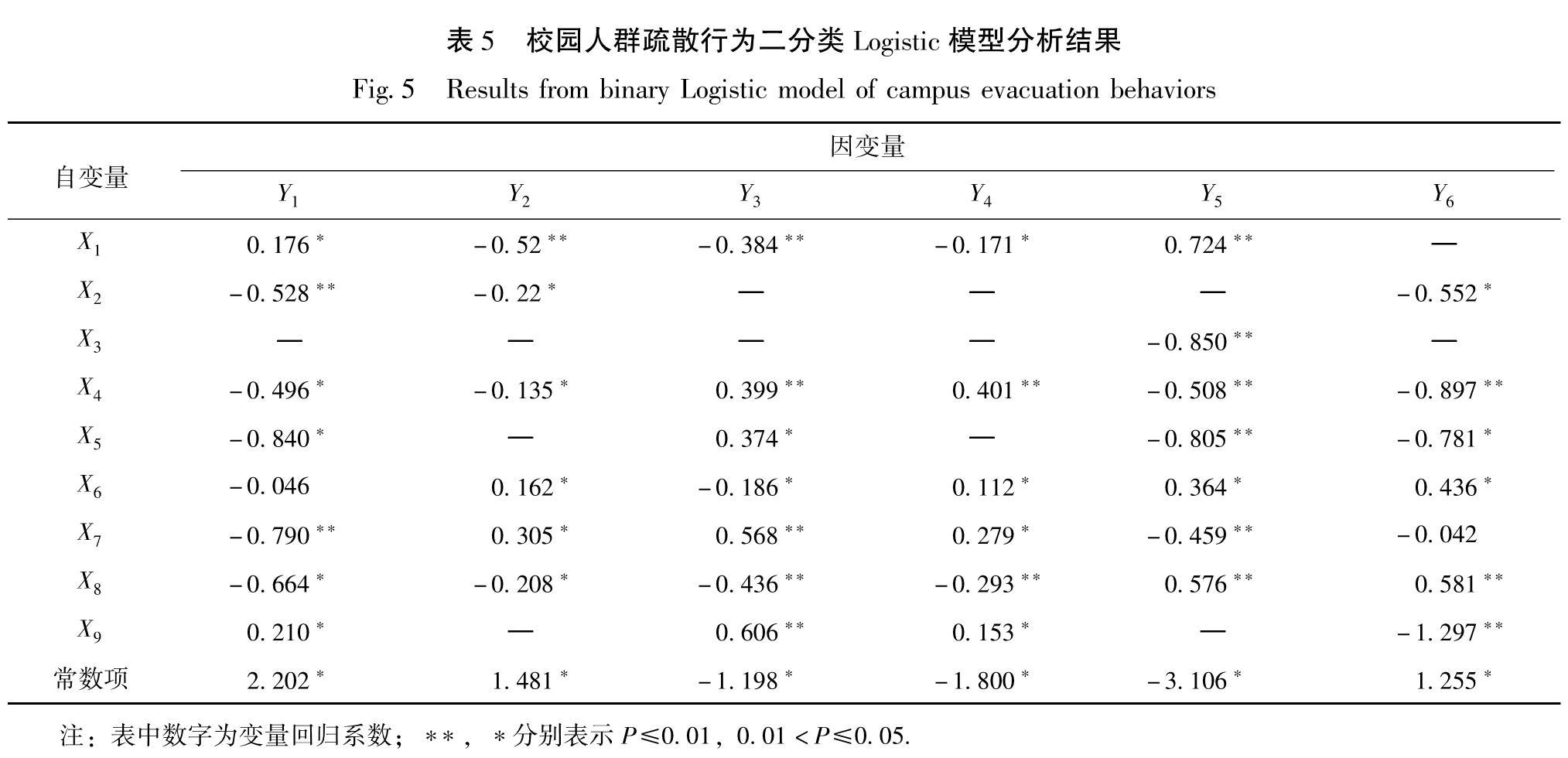基金项目:中国地震局江苏省典型城镇地震灾害风险评估项目和日本学术振兴会项目(18K03022)联合资助.
(1.南京大学 建筑与城市规划学院,江苏 南京 210093; 2.江苏省地震局,江苏 南京 210014)
校园安全意识; 疏散行为; 问卷调查; 相关性分析; Logistic 回归模型
(1.School of Architecture and Planning,Nanjing University,Nanjing 210093,Jiangsu,China)(2.Jiangsu Eauthquake Agency,Nanjing 210014,Jiangsu,China)
safety awareness on campus; evacuation behavior; questionnaire; correlation analysis; logistic regression model
DOI: 10.20015/j.cnki.ISSN1000-0666.2022.0016
备注
基金项目:中国地震局江苏省典型城镇地震灾害风险评估项目和日本学术振兴会项目(18K03022)联合资助.
引言
校园作为城市高密度地区,人员密集、空间相对封闭、建筑密度高、内部道路错综曲折、易损性高。为了保证师生安全,将校园人群快速疏散到安全区域,减小灾害造成的损失,制定合理、高效的灾时、灾后人群疏散策略及应急方案十分关键,因此开展校园人群应急疏散研究具有紧迫性与重要意义。影响应急疏散效率的因素包括疏散人员基本特征、空间环境、灾害环境及疏散行为策略等。人群疏散行为一直是国内外学界研究的热点,学者们采用视频观测(Cao et al,2018)、疏散实验(Xie et al,2020)、问卷调查、数值模拟(Zheng et al,2009)等方法研究人群在疏散过程中从众(Yunan,Tan,2007)、惯性(翟越等,2020)、避让(宋英华等,2020)、跟随行为(Wang et al,2020)、亲缘偏向行为(Yang et al,2005)等行为特征,以及恐慌(Shiwakoti et al,2019)、环境熟悉度(Li,Han,2015)等心理特征。其中问卷调查是最成熟、直观的研究方法。一些学者已对地铁(刘严萍等,2014)、车站(Shiwakoti et al,2016)、宿舍楼(阎卫东等,2006)、体育馆(代伟,2018)、机场(Shiwakoti et al,2020)等特定建筑尺度场景,以及工业园区(杨立兵,2012)、城镇片区尺度(陈容等,2014)的人群开展了关于安全意识及疏散行为的问卷调查研究。目前针对校园人群的安全意识和疏散行为研究较少,有关避难场所选择偏好、疏散拥堵时的路径选择、疏散行为影响因素及影响程度大小等研究较为匮乏。在现有校园疏散仿真模拟研究中,多考虑校园空间结构、道路、建筑布局对疏散时间的影响,依据需求点与避难场所的距离、容量建立疏散模型,较少考虑校园人群的心理状态、安全意识、疏散行为等因素。
[HJ2mm]本文以南京某高校为实证研究案例开展问卷调查。采用皮尔逊卡方检验法筛选出与疏散行为相关的变量,建立了人群特征、安全意识评价指标对校园内人群疏散行为影响的Logistic评价模型,识别疏散行为影响因素以及影响程度,以此指导校园内建筑、道路空间布局,避难场所规划,供校园应急疏散研究、疏散数值模拟以及制定合理有效的应急疏散方案参考,提升突发事件下校园应急疏散能力。需要指出的是,本文对避难场所偏好的调查研究只针对地震灾害,洪水灾害避难场所选择主要受高程影响,火灾只在局部发生,不会在城市片区尺度对人群避难场所选择上造成影响,选择地震灾害下的避难场所偏好研究是较有意义且合理的。
1 研究框架与问卷设计
灾时、灾后人群疏散是极为复杂的过程,已有研究表明人的性别、年龄、文化程度、性格类型、环境熟悉程度和疏散训练等6个因素对疏散效率有显著影响(杨立兵等,2012)。年龄与突发事件发生后的第一心理反应为显著相关变量组,受教育程度与安全意识指标、突发事件发生后的第一反应、出口选择为显著相关变量组(Shiwakoti et al,2020)。在制定疏散策略和方案中充分考虑外界环境因素的同时,还须考虑突发事件等紧急情况下校园人群的心理和行为特征。不同性别、年龄阶段的个体对灾害事件的敏感程度、认知能力不同,对空间环境的熟悉程度也不同。而灾害的风险认知、环境熟悉程度也会影响灾时疏散行为特征,因此,应当在总结已有研究的基础上,建立人群疏散行为影响因素理论模型(图1)。疏散行为分为被动疏散和主动疏散两类:被动疏散是指接收到官方强制信息后,行进到指定区域的行为; 主动疏散是指在接收到灾害信息后自发疏散、寻找避难空间的行为,也可称为避难行为。本文研究的疏散行为特指主动疏散,校园人群应急疏散行为分为3部分:接收到灾害信息到参与疏散前的响应及决策过程、地震灾害下避难场所的选择偏好、发生拥堵时的路径选择。
本文问卷调查的变量包括人员基本特征、安全意识和疏散行为等3种,见表1。人员特征包括性别、年龄、学历、参加疏散演练次数; 安全意识通过对各类突发事件的担忧程度和了解程度、校园避难场所的熟悉程度以及是否留意应急疏散指示牌来定量评价; 疏散行为包括听到警报后和意识到灾害发生时的第一反应与拥堵时的疏散选择,并且将避难过程中人群对避难场所的选择偏好纳入疏散行为调查研究。本文总共收集问卷493份,去除无效问卷15份,共收集有效样本容量为478份,占该校区总人数的5.12%。
2 问卷数据统计分析
4 应急避难规划及管理启示
5 结论
本文以南京中心城区某高校为实证研究案例,展开问卷调查。采用皮尔逊卡方检验法,对校园人群安全意识及疏散行为和性别、年龄、受教育程度及参加疏散演练次数等人员特性信息进行交叉分析,基于Logistic回归模型,建立了人群特性、安全意识评价指标对校园人群疏散行为及心理影响的评价模型,识别疏散行为影响因素,以及各因素的影响程度大小。主要得出以下结论:
(1)卡方检验结果表明,调查对象的年龄、性别以及参加过疏散演练的次数是影响人群安全意识及疏散行为的显著相关因素,调查对象的学历是相关因素。
(2)男性对校园避难场所的熟悉度高于女性。参加疏散演练次数越多的人群,知晓避难场所的个数越多,留意疏散指示牌的比例越大。调查对象对灾害的担忧程度与性别和年龄显著相关。女性对各类灾害的担忧程度、了解程度均显著高于男性。年长人群对气象灾害的担忧程度高于年轻人群。年轻人群对公共卫生事件、公共安全事件的担忧程度大于年长人群。参加疏散演练次数较多的人群,对灾害的了解程度更高,风险意识越强。
(3)地震灾害下受访人群对避难场所的选择偏好为:场地型避难场所>建筑型避难场所>地下空间。地震灾害下避难场所偏好选择与调查对象性别相关。男性选择进入地下空间和大型体育馆避难的比例显著高于女性。
(4)拥堵时的路径选择与性别、年龄以及参加过疏散演练的次数显著相关,男性选择寻找其它疏散通道的比例比女性更高。女性选择排队等待的比例高于男性。年龄越大,越倾向于在原地排队等待。参加疏散演练的次数越多,拥堵时主动寻找其他避难空间的人群比例越大,选择“向前挤”等不冷静疏散行为的比例越少。
(5)灾后第一反应与性别、年龄以及参加过疏散演练的次数相关。男性逃生反应更加迅速,女性更容易受到周围人群的影响。年龄越大的人群疏散时更为冷静,不易受周围人群的影响,传递灾害信息的意愿更强。参加疏散演练次数越多的人群,立即撤离的概率越大,不易受周围人群疏散行为的影响。
(6)人群参加疏散演练的次数、安全意识、风险认知对灾害发生时的疏散行为有显著影响。基于疏散行为分析,提出完善建筑布局、道路网络、避难场所及避难路径规划、提高疏散避难空间的可识别性、加强疏散演练及防灾教育、人群对校园环境的熟悉程度、推动校园整体营造,提升灾时信息传递能力等应急避难规划及管理策略,有助于人群在灾害发生时更迅速、更主动地开始疏散行动,在疏散过程中冷静地选择合理的疏散路径和避难目的地,提升校园整体疏散效率。
作为本文研究对象的南京市某高校为综合性大学,学科设置齐全,师生年龄结构合理,性别比例接近1:1,具有一定代表性,问卷调查的结论具有一定实际意义和普适性。本文的局限性在于部分结论只适用于性别比例接近1:1的综合性大学,在师范类院校、体育类院校等性别比例较为悬殊的学校,疏散行为与年龄、学历、参加疏散演练次数、安全意识之间的相关性方面得出的结论仍然适用,但在疏散行为与性别之间的相关性,以及性别因素对疏散行为的影响程度方面,仍需要进一步研究。此外,本文实证研究案例选取高等院校人群,与校园外广大人群相比,受教育程度较高,年龄分布较为集中,社会经历较为不足,在安全意识及疏散行为决策上会有所差异。在今后的研究中,应扩大研究对象的范围,在中央商务区(CBD)、医疗单位、城市客运站等其他高密度地区开展调查研究,以加强高密度地区人群疏散行为研究的普适性、说服力。
校园规划设计中应将防灾减灾理论和应急疏散影响因素融入其中,制定校园应急预案。设计人员应基于人群性别、年龄等基本特征,安全意识和风险认知,以及疏散引导系统、避难场所容量等外部空间环境因素对避难场所及疏散通道选择的影响,掌握避难场所真实利用率,优化避难场所空间配置和建筑布局,完善疏散路径的具体规划和设计。
4.1 整体层面完善建筑布局、道路网络、避难场所及避难路径规划基于校园内人口规模、建筑分布、各类潜在避难场所布局,确定所需的避难场所和避难疏散通道的数量、规模。基于问卷调查获取校园内人群应急疏散行为决策、避难场所偏好、拥堵时避难疏散路径选择,计算每栋建筑的人群选择特定避难空间的概率,改进传统需求点—避难场所点(OD)模型,得出应急疏散过程中人群空间分布规律,更精确地模拟应急疏散过程。采用元胞自动机模型、社会力模型或多智能体模型完成校园应急疏散仿真疏散模拟,得到校园人群疏散至避难场所需要的总时间; 基于此对不同的校园规划或更新方案进行评价,优化调整道路网络结构、建筑布局、避难场所容量及布局,确定疏散时间最小的方案; 同时基于疏散时间对校园内疏散通道进行优化设计,实现应急避难所空间配置的循环校验,建立分区应急疏散策略,提出基于应急疏散行为仿真的校园规划设计框架(图4)。
4.2 提高疏散避难空间的可识别性校园人群对于避难空间的熟悉程度(包括知晓校园避难场所的个数、是否留意校园内应急疏散指示牌)显著影响疏散决策行为是否理性、合理,影响疏散效率。因此疏散路径和避难场所及疏散路径在空间上需具备较强的可识别性。应增设避难场所、避难通道标识物,从而带来有利的应急疏散人群、提升疏散效率。
4.3 加强疏散演练及防灾教育参加疏散演练经验越多,人群的安全意识越强,逃生反应也会更加迅速。对校园人群定期开展疏散演练,加强安全教育,提升风险意识,增加人群对校园环境的熟悉程度,将有助于校园人群在灾害发生时更迅速、更主动地开始疏散,在疏散过程中选择冷静、合理的疏散路径和避难目的地。推动校园整体营造,提升灾时信息传递能力,促进灾时自救互救。此外,依据不同建筑的空间布局、人口,避难场所的空间布局、容量,制定合理的分区疏散策略,指导每栋建筑的校园人群前往指定的避难空间,能提升疏散效率,减少疏散过程中的人员伤亡。
- 陈容,崔鹏,苏志满,等.2014.汶川地震极重灾区公众减灾意识调查分析[J].灾害学,29(2):228-233.
- 代伟.2012.群集应急疏散影响因素及时间模型研究[D].长沙:中南大学.
- 靳文博,翟国方,何仲禹,等.2018.基于有序Logistic回归的城市总体规划建设用地指标与城市居民主观幸福感间关系研究[J].国际城市规划,33(6):110-117.
- 刘严萍,王世通,赖迪辉.2017.天津地铁乘客火灾疏散行为特征调查研究[J].灾害学,32(4):169-172.
- 宋英华,张宇,霍非舟,等.2020.考虑避让行为的人员疏散元胞自动机模型研究[J].系统仿真学报,32(6):975-981.
- 童林旭.2012.地下建筑学[M].北京:中国建筑工业出版社.
- 阎卫东,梁清山,陈宝智.2006.火灾情况下疏散心理和行为在不同层次起点学生中的差别研究[J].中国安全科学学报,16(3):8-11.
- 杨立兵,王亮,陈建宏,等.2012.企业火灾疏散人员行为及心理特征研究[J].中国安全科学学报,22(5):3-9.
- 翟越,薄杰,侯亚楠,等.2020.考虑多因素的元胞自动机室内人员疏散模拟研究[J].灾害学,35(4):72-76.
- Cao S,Fu L,Wang P,et al.2018.Experimental and modeling study on evacuation under good and limited visibility in a supermarket[J].Fire Safety Journal,102:27-36.
- Li D,Han B.2015.Behavioral effect on pedestrian evacuation simulation using cellular automata[J].Safety Science,80:41-55.
- Shiwakoti N,Shi X,Ye Z.2019.A review on the performance of an obstacle near an exit on pedestrian crowd evacuation[J].Safety Science,113:54-67.
- Shiwakoti N,Tay R,Stasinopoulos P,et al.2016.Passengers' awareness and perceptions of way finding tools in a train station[J].Safety Science,87:179-185.
- Shiwakoti N,Wang H,Jiang H,et al.2020.A ‘role~rule' model to examine passengers' likely behaviour and their perceived ability to evacuate safely from airport in an emergency evacuation[J].Safety Science,124:104584.
- Wang X,Liu Z,Zhao Z,et al.2020.Passengers' likely behaviour based on demographic difference during an emergency evacuation in a Ro~Ro passenger ship[J].Safety Science,129:104803.
- Xie W,Lee E,Cheng Y,et al.2020.Evacuation performance of individuals and social groups under different visibility conditions:Experiments and surveys[J].International Journal of Disaster Risk Reduction,47:101527.
- Yang L Z,Zhao D L,Li J,et al.2005.Simulation of the kin behavior in building occupant evacuation based on cellular automaton[J].Building and Environment,40(3):411-425.
- Yuan W F,Tan K H.2007.An evacuation model using cellular automata[J].Physica A,384:549-66.
- Zheng X,Zhong T,Liu M.2009.Modeling crowd evacuation of a building based on seven methodological approaches[J].Building and Environment,44(3):437-445.
2.1 样本基本特征问卷调查对象以高年级本科生和研究生为主,18~25岁、26~35岁、36~55岁、56岁以上的受访对象分别占比60.2%、13.0%、6.9%以及2.4%; 本科生、硕士生、博士生分别占22.4%、54.6%、12.8%,已取得博士学位的教师占12.76%; 男性占比53.8%、女性占比46.2%。根据学校官网及各学院的统计数据,校园内本科生2 012人,硕士生5 211人,博士生1 237人,教师1 081人,在人群的总体构成中,分别占比20.5%、52.7%、15.1%和11.6%。本文样本的年龄结构、学历结构与该校园人群总体构成基本吻合。从未参加过疏散演练的人群占总人数的25.5%,参加过1~2次、3~4次、4次以上分别占总人数的42.1%、18.4%、14.0%。47.5%的人群留意了校园内应急避难场所; 25.3%的人群购买了灾害保险; 完全不了解校园避难场所、只知道1~2个避难场所的人群比例分别达到了18.8%和51.9%,了解15个以上避难场所的人群比例仅为2.3%。受访对象中从未参加过疏散演练的人群比例为25.5%,参加过1~2次的比例为42.1%,表明校园人群的安全意识有待提升。
2.2 不同性别人群的安全意识及疏散行为2.2.1 安全意识差异(1)男性知晓校园避难场所15个以上、11~15个、6~10个的比例分别是7.8%、4.3%、4.7%; 女性的比例分别是2.7%、0.9%、5.9%。
(2)在对各类灾害事件的了解程度上,女性均略高于男性(图2)。
2.2.2 疏散行为特征(1)疏散中发生拥堵时,男性选择“寻找其它疏散通道”比例比女性更高。
(2)当听到警报后,43.6%的男性和29%的女性会立即撤离; 30.1%的男性和44.8%的女性第一反应是看周围人的反应; 15.2%的男性和14.5%女性第一反应是向学校工作人员询问; [HJ2.1mm]8.95%的男性和9.9%的女性第一反应是通知老师和同学。男性逃生反应更加迅速,女性所需要的逃生准备时间更长、且更容易受到周围人群的影响。
(3)在避难场所的选择偏好上,地震发生后,20.6%的男性和13.6%的女性愿意进入大型体育馆避难; 87.5%的男性和81%的女性愿意去操场避难; 63.4%的男性和51.1%的女性愿意去露天体育场避难; 选择进入地下空间避难的男性比例大于女性。
2.3 不同年龄人群的安全意识及疏散行为2.3.1 安全意识差异在对各类灾害的担忧程度上,年长人群对气象灾害的担忧程度略大于年轻人群。年轻人群对公共卫生事件、公共安全事件的担忧程度大于年长人群。
2.3.2 疏散行为特征(1)在疏散过程中发生拥堵时,超过56岁的人群中仅有7.1%选择寻找其它避难场所,36~55岁、26~35岁、18~25岁人群中这一比例分别为40%、66.7%、67%。超过56岁的人群中有78.6%选择排队等待,而36~55岁、26~35岁、18~25岁的人群排队等待的比例依次降低。受访人群在疏散过程中发生拥堵时的选择与受访者年龄显著相关。年龄越大,越倾向于排队等待,寻找其它避难场所的比例越小。
(2)当意识到灾害发生时,超过56岁的人群中仅有14.3%选择立即撤离,18~25岁、26~35岁、36~55岁人群中这一比例分别为63.5%、53.3%、37.5%,年龄越大的人群,疏散准备时间越长。56岁以上和36~55岁的人群灾后第一反应是通知老师和同学的比例分别为50%和17.5%,显著大于18~25岁和26~35岁的人群。56岁以上和36~55岁的人群看周围人反应的比例仅为7.1%和5%。年龄越大,在灾害发生后更为冷静,不易受周围人的影响,且传递信息的意识更强。
2.4 参加不同疏散演练次数人群的安全意识及疏散行为2.4.1 安全意识差异(1)受访人群知晓校园避难场所的个数与参加过疏散演练的次数显著相关。从未参加过、参加过1~2次、3~4次和4次以上的人群知晓15个以上避难场所的比例分别是4.9%、3.5%、4.6%和13.4%,知晓6~15个以上避难场所的比例分别是0.8%、1.5%、5.7%和10.5%。
(2)是否留意应急疏散指示牌,是否购买灾害保险与人群参加过疏散演练的次数具有相关性。从未参加过疏散演练、参加过1~2次、3~4次和4次以上的人群留意了疏散指示牌的比例分别是39.3%、47.3%、45.5%和62.7%。人群参加疏散演练的次数越多,购买了灾害保险的比例越大,留意疏散指示牌的比例也越大。
(3)参加疏散演练次数较多的人群,对灾害事件的了解程度越高、风险意识越强(图3)。
2.4.2 疏散行为特征(1)在疏散过程中发生拥堵时,从未参加过疏散演练、参加过1~2次、3~4次和4次以上的人群选择排队等待的比例分别是42.6%、30.9%、26.1%和14.9%,选择寻找其它避难通道的比例依次是50.8%、64.7%、68.2%和80.6%。参加疏散演练的次数越多,在遇到拥堵时主动寻找其它避难场所或避难通道的人群比例越大,选择“向前挤”等不冷静疏散行为的比例也就越小。
(2)当听到警报后,从未参加过疏散演练、参加过1~2次、3~4次和4次以上的人群选择排队等待的比例分别是22.9%、37.3%、31.8%和55.2%,而选择看周围人的反应的比例依次降低。
(3)在避难场所选择方面,未参加过疏散演练、参加过1~2次、3~4次和4次以上的人群愿意进入地下车库的比例分别是12.4%、8.4%、6.2%和4.4%; 愿意进入大型体育场馆避难的人群的比例分别是31.1%、11.9%、15.9%和10.4%。参加过疏散演练的次数较多的人群,进入地下车库和体育场馆避难的意愿呈现变低趋势。
总的来说,听到警报后,仅有36.8%的人群会立即撤离,而37%的人群第一反应是看周围人的反应。 选择向学校工作人员询问,以及通知老师和同学的比例分别为14.9%和9.4%。当意识到灾害发生时,58.2%的人群会立即撤离,15.3%的人群第一反应是看周围人反应,选择向学校工作人员询问,通知老师和同学的比例为6.5%和6.9%。接收到灾害信息后立即撤离的人群比例较低,持从众心理的人群比例较高,需加强防灾教育及疏散演练,缩短应急疏散反应时间。
避难场所选择方面,愿意进入大型体育馆、操场、公园绿地、地下车库、地下商业城、地铁、广场以及露天停车场的人群比例分别为17.4%、85.6%、69.2%、7.7%、8.4%、3.6%、56.9%和61.9%; 地震灾害下人群对避难场所的选择偏好为:场地型避难场所>建筑型避难场所>地下空间。地下空间自身虽然有一定的防灾性,同一地点下抗震性能优于地上建筑结构(童林旭,2012),在气象灾害、爆炸等突发灾害事件下能作为有效掩体,但由于其密闭性、内部可视性差、通行效率低下、人群处在地下空间中不易掌握周围灾害环境的变化,因此逃往地下空间的人群比例较低。地震发生后,通常伴随余震,建筑型避难场所存在震损风险,因此人群更倾向于选择场地型避难场所。
[BT(1]3 Logistic回归模型研究
通过皮尔逊卡方检验筛选出与疏散行为相关的变量,采用 Logistic 回归模型(靳文博等,2018)建立人群疏散行为与基本特征、安全意识的评价模型,模型中自变量见表2。性别、年龄、学历、参加疏散演练次数、知晓避难场所的个数为多分类变量; 是否购买灾害保险、是否留意校园内应急避难指示牌为二分类变量; 对灾害的担忧程度和了解程度为连续变量,每位受访者对灾害的担忧程度和了解程度取表1中对各类灾害担忧值、了解值的平均值。
内容[]变量名[]变量含义[]赋值情况[BHD][]X1[]年龄[]18岁以下=0; 18~25岁=1; 26~35岁=2; 36~55岁=3; 56岁以上=4[BHDW][KH*2/3D]人员特征因素[]X2[]性别[]男=0; 女=1[BH][]X3[]学历[]本科在读=1; 硕士在读=2; 博士在读=3; 学校教师=4[BH][]X4[]参加疏散演练次数[]0次=0; 1~2次=1; 3~4次=3; 4次以上=4[BHD][]X5[]是否购买了灾害保险[]是=0; 否=1[BHDW][]X6[]灾害担忧程度[]完全不担心=0; 基本不担心=1; 不会很担心=2; 比较担心=3; 非常担心=4[BH]安全意识[]X7[]灾害了解程度[]完全不了解=0; 基本不了解=1; 偶尔听闻过=2; 比较了解=3; 非常了解=4[BH][]X8[]知晓校园避难场所的个数[]0个=0; 1~2个=2; 3~5个=3; 6~10个=4; 11~15个=5; 15个以上=6[BH][]X9[]是否留意应急疏散指示牌[]是=0; 否=1[BG)F][HT] 模型中的因变量为6类,其含义及赋值见表3。其中,倾向于逃往的避难场所以是否选择大型体育馆和地下车库为代表,将听到警报后或意识到灾害发生时的第一反应的选项整合为等待救援和立即撤离,疏散过程中和在进入避难场所的入口处发生拥堵时的选择整合为排队等待和寻找其他避难场所(通道),均为二分类变量。对模型不同变量进行单因素卡方检验(表4),挑选出有相关性的自变量与因变量。p值为原假设H0成立时或是出现极小概率事件时的概率。将p值与给定的显著水平进行比较,确定原假设成立与否。若p<0.05,则原假设不成立,2个变量具有相关性,当p<0.01时,说明2个变量显著相关; p>0.05时,原假设条件成立,2个变量相互独立。最后完成校园人群疏散行为的Logistic回归分析,见表5。
表5 校园人群疏散行为二分类Logistic模型分析结果
Fig.5 Results from binary Logistic model of campus evacuation behaviors表5 校园人群疏散行为二分类Logistic模型分析结果
Fig.5 Results from binary Logistic model of campus evacuation behaviors根据二元Logistic模型表达式及变量定义,得到听到警报后校园人群选择立即撤离的概率为:

校园人群选择等待救援的概率为:

Logistic模型表达式为:

人群年龄、性别、参加过疏散演练的次数、是否购买灾害保险、灾害了解程度、知晓避难场所个数、是否留意疏散指示牌、对校园人群是否选择地下车库避难有影响,其中是否购买灾害保险和知晓避难场所的个数的变量回归系数绝对值大于其它因素,对听到警报后第一反应的影响程度最大。
同理,计算得到意识到灾害发生时的第一反应、拥堵时的选择、是否选择大型体育馆、是否选择地下车库5种疏散行为的Logistic模型表达式:
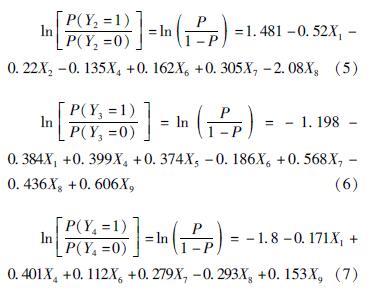
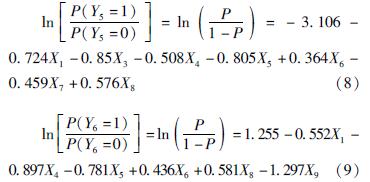
人群参加疏散演练的次数(X4)对6种疏散行为均有影响,变量回归系数大,对疏散行为的影响程度大。此外,人群安全意识因素,如知晓校园避难场所的个数、是否留意校园内应急疏散指示牌、对灾害的了解程度和担忧程度,会显著影响人群疏散行为。人群的年龄对其意识到灾害后的第一反应影响最大; 是否留意应急疏散指示牌、知晓避难场所的个数、对灾害的了解程度对疏散过程中发生拥堵时的选择影响较大; 参加疏散演练的次数、知晓避难场所的个数对避难场所入口处发生拥堵时的选择影响较大; 年龄、学历对是否选择进入地下车库避难影响较大; 是否留意应急疏散指示牌、参加疏散演练的次数对是否选择进入大型体育馆避难影响较大。
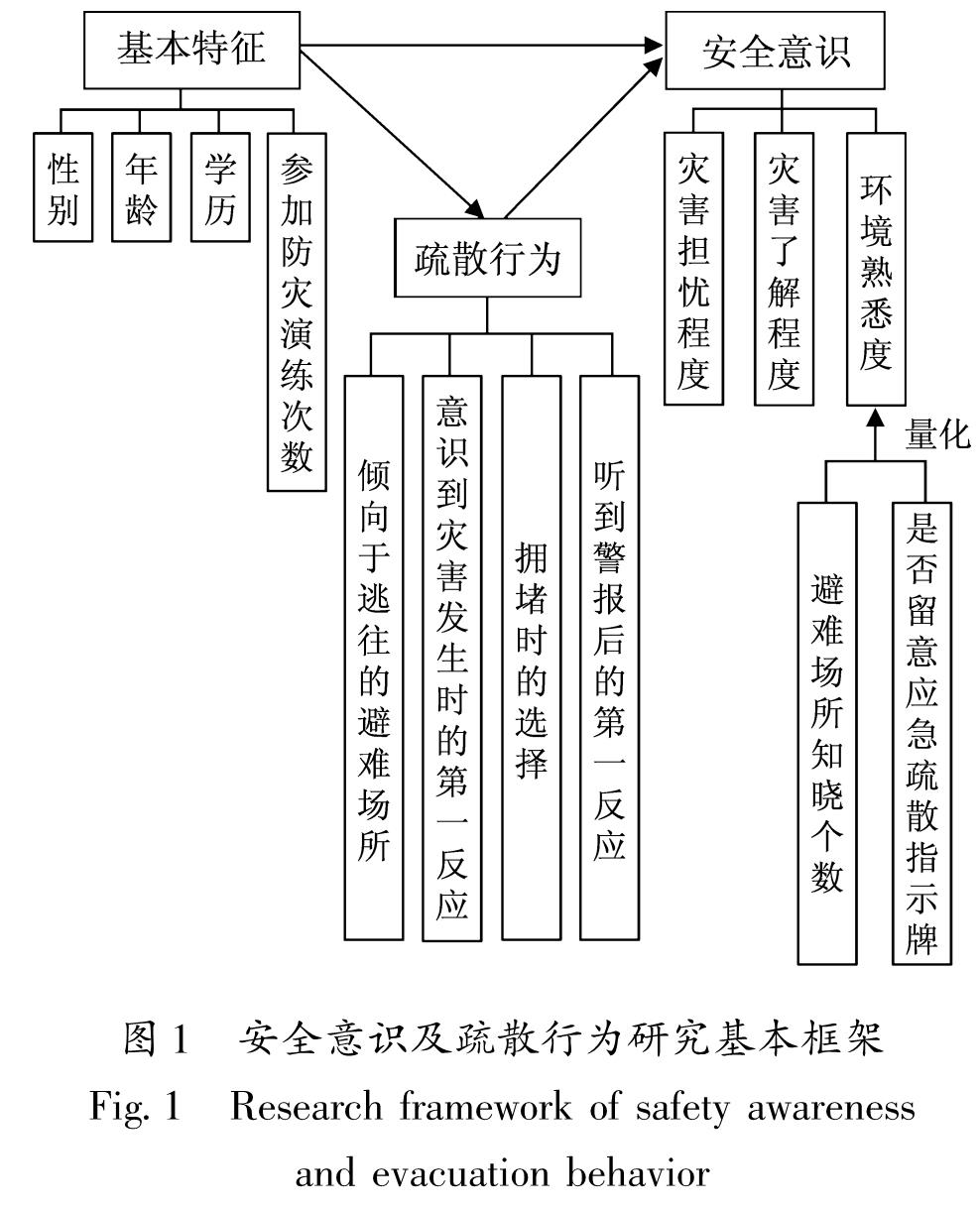
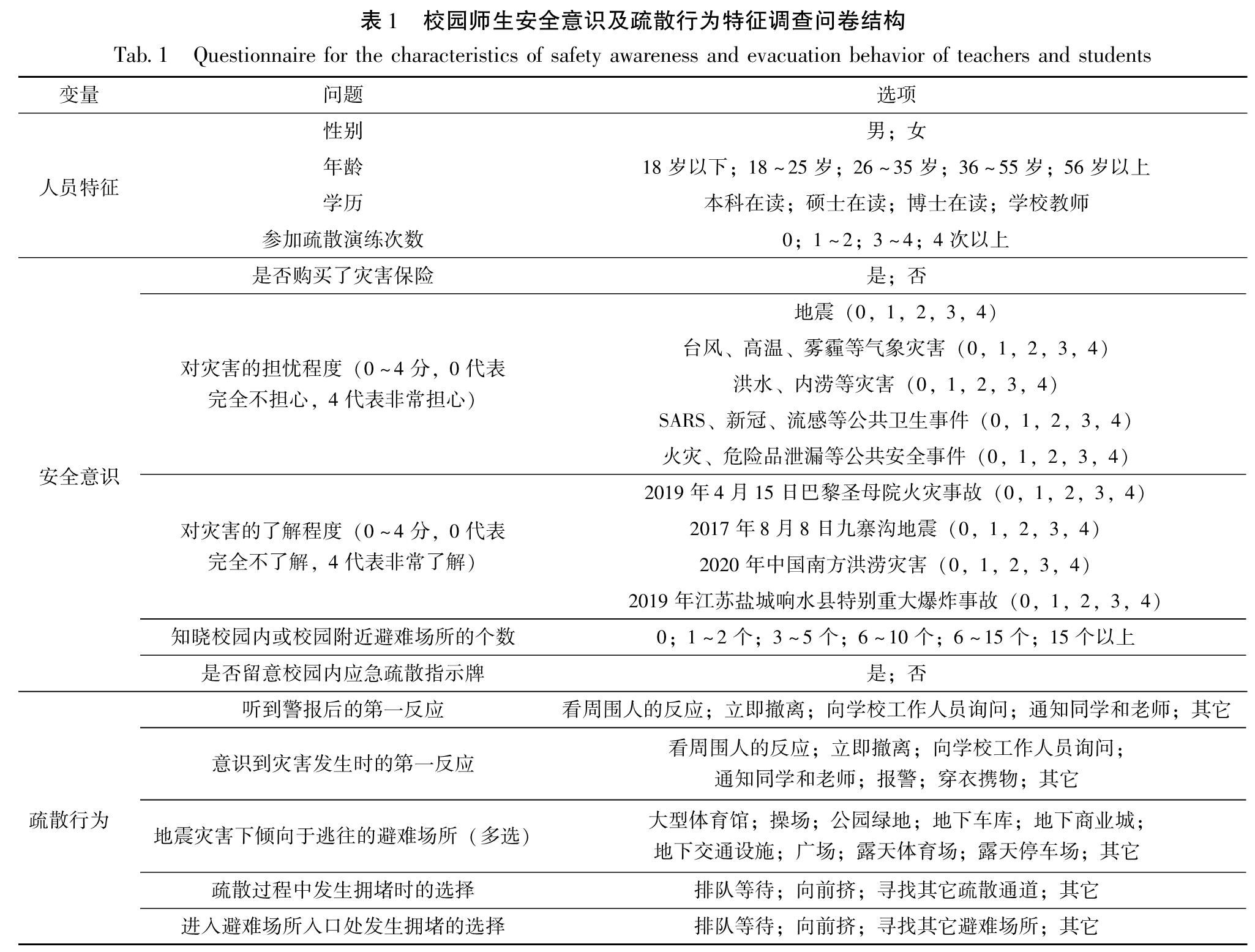

![图3 参加不同疏散演练次数的人群对灾害的了解程度<br/>Fig.3 Understanding degree of disasters of respondents with different times of participating in evacuation drill[HT]](2022年01期/pic135.jpg)



